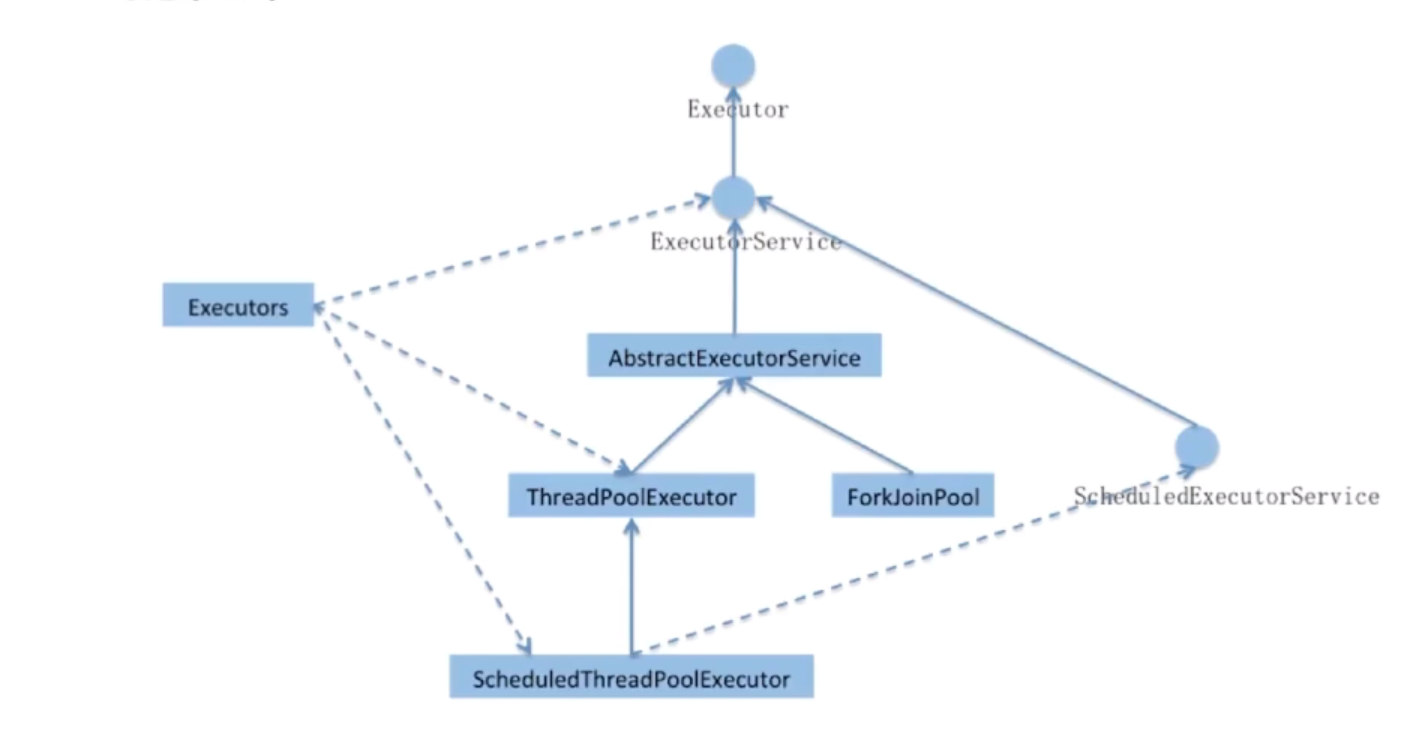一、java.util.concurrent包下的线程池相关的类和接口

JUC包下的三个接口:
1、Executor:运行新任务的简单接口,将任务提交和任务执行细节解耦
2、ExecutorService:具备管理执行器和任务生命周期方法,提交任务机制更完善
3、ScheduledExecutorService:支持Future和定期执行任务
ThreadPoolExecutor、ForkJoinPool、ScheduledThreadPoolExecutor使用创建线程池实例的,通过executors工具类来创建:
1、newFixedThreadPool(int nThreads)
指定工作线程数量的线程池
public static ExecutorService newFixedThreadPool(int nThreads) { return new ThreadPoolExecutor(nThreads, nThreads, 0L, TimeUnit.MILLISECONDS, new LinkedBlockingQueue<Runnable>()); }
2、newCachedThreadPool()
处理短时间工作任务的线程池,
(1)试图缓存线程并重用,当无缓存线程可用,就会创建新的工作线程;
(2)如果线程闲置时间超过阀值,则会被终止并移除缓存。
(3)系统长时间闲置时,不会消耗什么资源
执行execute方法时,首先会先执行SynchronousQueue的offer方法提交任务,并查询线程池中是否有空闲线程来执行SynchronousQueue的poll方法来移除任务。如果有,则配对成功,将任务交给这个空闲线程。否则,配对失败,创建新的线程去处理任务;当线程池中的线程空闲时,会执行SynchronousQueue的poll方法等待执行SynchronousQueue中新提交的任务。若超过60s依然没有任务提交到SynchronousQueue,这个空闲线程就会终止;因为maximumPoolSize是无界的,所以提交任务的速度 > 线程池中线程处理任务的速度就要不断创建新线程;每次提交任务,都会立即有线程去处理,因此CachedThreadPool适用于处理大量、耗时少的任务。
public static ExecutorService newCachedThreadPool() { return new ThreadPoolExecutor(0, Integer.MAX_VALUE, 60L, TimeUnit.SECONDS, new SynchronousQueue<Runnable>()); }
3、newSingleThreadExcutor()
创建唯一的工作线程来执行任务,如果线程异常结束,会有另一个线程来取代他。
public static ExecutorService newSingleThreadExecutor() { return new FinalizableDelegatedExecutorService (new ThreadPoolExecutor(1, 1, 0L, TimeUnit.MILLISECONDS, new LinkedBlockingQueue<Runnable>())); }
4、newSingleThreadScheduledExcutor()与newScheduledThreadPool(int corePoolSize)
定时或者周期性的工作调度,两者的区别在于单一的工作线程还是多个线程
public static ScheduledExecutorService newSingleThreadScheduledExecutor() { return new DelegatedScheduledExecutorService (new ScheduledThreadPoolExecutor(1)); }
5、newWordStealingPool()
内部会构建ForkJoinPool,利用working-stealing算法,并行的处理任务,不保证处理顺序。
fork/join把大任务切割成小任务执行,最终汇总每个小任务结果后得到大任务结果的框架。
public static ExecutorService newWorkStealingPool() { return new ForkJoinPool (Runtime.getRuntime().availableProcessors(), ForkJoinPool.defaultForkJoinWorkerThreadFactory, null, true); }
可以看出:
newFixedThreadPool(int nThreads)、newCachedThreadPool()、newSingleThreadExcutor()使用的是ThreadPoolExecutor类来创建线程;
newSingleThreadScheduledExcutor()与newScheduledThreadPool(int corePoolSize)使用的是ScheduledThreadPoolExecutor类;
newWordStealingPool()使用的是ForkJoinPool类。
运行一个线程池:
import lombok.SneakyThrows; import java.util.concurrent.*; public class ThreadPoolTest { @SneakyThrows public static void main(String[] args){ Executor executor = Executors.newFixedThreadPool(3); executor.execute(new MyRunnable()); } static class MyRunnable implements Runnable{ @SneakyThrows @Override public void run() { System.out.println(Thread.currentThread().getName()+":is start..."); Thread.sleep(300); System.out.println(Thread.currentThread().getName()+":is over..."); } } }
二、通过ThreadPoolExecutor构造一个线程池需要用到的参数。
1、corePoolSize:核心线程数,长久存在
2、maximumPoolSiz:最大线程数
3、workQueue:任务等待队列,java默认的等待队列没有限制,会无限存放,容易造成内存泄漏。
4、keepLiveTime:空闲线程(大于corePoolSize数的线程)的存在时间
5、TimeUnit:一个时间类型的枚举类。有从纳秒到天的时间量度,配合上面的keepAliveTime确定非核心线程的存活时间。
6、threadFactory:线程工厂,创建新线程,Executors.defaultThreadFactory()
7、RejectedExecutionHandler:线程池饱和策略,有以下4种
AbortPolicy:直接抛弃异常,这是默认策略
CallerRunsPolicy:用调用者所在的线程来执行任务
DiscardOldestPolicy:丢弃队列中靠最前的任务,并执行当前任务
DiscardPolicy:直接丢弃任务
实现RejectedExecutionHandlerjiekou的自定义handler。
自定义一个线程池:
import lombok.SneakyThrows; import java.util.concurrent.*; public class ThreadPoolTest { @SneakyThrows public static void main(String[] args){ int corePoolSize = 3;//核心线程数 int maximumPoolSize = 10;//最大线程数 int keepAliveTime = 2;//空闲线程存活时间 TimeUnit unit = TimeUnit.MILLISECONDS;//keepAliveTime时间单位 BlockingQueue<Runnable> queue = new LinkedBlockingQueue<>();//等待队列 ThreadFactory threadFactory = Executors.defaultThreadFactory();//线程工厂,用于创建线程 RejectedExecutionHandler handler = new ThreadPoolExecutor.AbortPolicy();//线程池饱和策略 ExecutorService executor = new ThreadPoolExecutor( corePoolSize, maximumPoolSize, keepAliveTime, unit, queue, threadFactory, handler ); executor.execute(new MyRunnable()); } static class MyRunnable implements Runnable{ @SneakyThrows @Override public void run() { System.out.println(Thread.currentThread().getName()+":is start..."); Thread.sleep(300); System.out.println(Thread.currentThread().getName()+":is over..."); } } }
结果:
pool-1-thread-1:is start...
pool-1-thread-1:is over...
三、当线程池有新任务提交execute执行时。

1、如果线程池中的线程少于corePoolSize,则创建新的线程来处理任务,即使线程池中的其他线程是空闲的。
2、如果线程池中的的线程大于corePoolSize且小于maximunPoolSize,则只用当workQueue满时才创建新的线程去处理任务。
3、如果设置的corePoolSize和maximumPoolSize相同,若workQueue未满,则将请求放入workQueue中,等待有空闲的线程去workQueue中取任务。
4、如果运行的线程数量大于等于maximumPoolSize,这时如果workQueue已经满了,则通过handler所指定的策略来处理任务。
四、线程池的状态

running:能接受新提交的任务,并且也能处理阻队列中的任务
shutdown:等待线程任务完成,不再接受新提交的任务,也不处理队列中的任务
stop:不等待线程任务完成,不再接受新提交的任务,也不处理队列中的任务
tidying:所有的任务都已终止
terminated:terminated()方法执行完后进入的状态
五、ExecutorService中的方法
1、submit,可以接收返回值
<T> Future<T> submit(Callable<T> task);
需要先实现Callable接口,Callable是个函数式接口,类似于Runnable,但是它的call方法需要设定返回值类型。
submit传回一个Future对象,调用它的get方法可以获得返回值。
结果:
2、关闭线程池
shutdown方法,等待所有线程执行完毕后,不再接受新提交的任务,也不处理队列中的任务,然后关闭线程池。
shutdownNow,立即关闭线程池,不等待线程执行完毕。
import lombok.SneakyThrows; import java.util.concurrent.*; public class ThreadPoolTest { @SneakyThrows public static void main(String[] args){ int corePoolSize = 3;//核心线程数 int maximumPoolSize = 10;//最大线程数 int keepAliveTime = 2;//空闲线程存活时间 TimeUnit unit = TimeUnit.MILLISECONDS;//keepAliveTime时间单位 BlockingQueue<Runnable> queue = new LinkedBlockingQueue<>();//等待队列 ThreadFactory threadFactory = Executors.defaultThreadFactory();//线程工厂,用于创建线程 RejectedExecutionHandler handler = new ThreadPoolExecutor.AbortPolicy();//线程池饱和策略 ExecutorService executor = new ThreadPoolExecutor( corePoolSize, maximumPoolSize, keepAliveTime, unit, queue, threadFactory, handler ); executor.execute(new MyRunnable()); // executor.shutdown(); // executor.shutdownNow(); } static class MyRunnable implements Runnable{ @SneakyThrows @Override public void run() { System.out.println(Thread.currentThread().getName()+":is start..."); Thread.sleep(300); System.out.println(Thread.currentThread().getName()+":is over..."); } } }
使用shutdown:
pool-1-thread-1:is start...
pool-1-thread-1:is over...
使用shutdownNow:
pool-1-thread-1:is start... Exception in thread "pool-1-thread-1" java.lang.Error: java.lang.InterruptedException: sleep interrupted at java.util.concurrent.ThreadPoolExecutor.runWorker(ThreadPoolExecutor.java:1155) at java.util.concurrent.ThreadPoolExecutor$Worker.run(ThreadPoolExecutor.java:624) at java.lang.Thread.run(Thread.java:748) Caused by: java.lang.InterruptedException: sleep interrupted at java.lang.Thread.sleep(Native Method) at com.imooc.basic.thread.ThreadPoolTest$MyRunnable.run(ThreadPoolTest.java:41) at java.util.concurrent.ThreadPoolExecutor.runWorker(ThreadPoolExecutor.java:1149) ... 2 more
之所以会产生异常,因为shutdownNow方法会调用了线程的Interrupted方法,这里没有处理异常而是直接抛出。但是从结果可以看出线程没有over,已被中断。
import lombok.SneakyThrows; import java.util.concurrent.Executor; import java.util.concurrent.Executors; public class ThreadPoolTest { public static void main(String[] args){ Executor executor = Executors.newFixedThreadPool(3); executor.execute(new ThreadTest()); } static class ThreadTest implements Runnable{ @SneakyThrows @Override public void run() { System.out.println(Thread.currentThread().getName()+":is start..."); Thread.sleep(300); System.out.println(Thread.currentThread().getName()+":is over..."); } } }